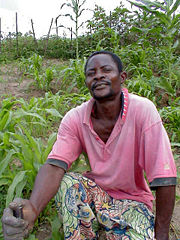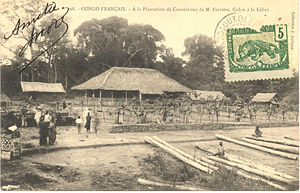
Agriculture in the Democratic Republic of the Congo
Encyclopedia
Agriculture in the Democratic Republic of the Congo is an industry
in the country of the Democratic Republic of the Congo
that has plenty of potential.
, yams
, plantain
s, rice
, and maize
. The country is not drought-prone but is handicapped by a poor internal transportation system, which impedes the development of an effective national urban food-supply system.
 Land under annual or perennial crops constitutes only 3.5 percent of the total land area. Agriculture is divided into two basic sectors: subsistence, which employs the vast majority of the work force, and commercial, which is export-oriented and conducted on plantations. Subsistence farming involves four million families on plots averaging 1.6 hectares (four acres), usually a little larger in savanna
Land under annual or perennial crops constitutes only 3.5 percent of the total land area. Agriculture is divided into two basic sectors: subsistence, which employs the vast majority of the work force, and commercial, which is export-oriented and conducted on plantations. Subsistence farming involves four million families on plots averaging 1.6 hectares (four acres), usually a little larger in savanna
areas than in the rain forest. Subsistence farmers produce mainly manioc, corn
, tubers, and sorghum
. In 2004, food-crop production included manioc, 14,950,000 tons; sugarcane
, 1,787,000 tons; corn, 1,155,000 tons; peanuts
, 364,000 tons; and rice
, 315,000 tons. In 2004, plantains totalled 1,199,000 tons; sweet potatoes, 224,500 tons; banana
s, 313,000 tons; yams, 84,000 tons; and pineapples, 193,000 tons. Domestic food production is insufficient to meet the country’s needs, and many basic food products have to be imported.
, rubber
, palm oil
, cocoa, tea
) was mostly back in private hands. Commercial farmers number some 300,000, with holdings between 12 and 250 hectares (30 and 618 acres).
 Coffee is the DROC’s third most important export (after copper
Coffee is the DROC’s third most important export (after copper
and crude oil) and is the leading agricultural export. An estimated 33,000 tons were produced in 2004 (down from an average of 97,000 tons during 1989–91); 80 percent of production comes from the provinces of Haut Zaire, Equateur
, and Kivu
. Only 10–15 percent of production is arabica coffee, the vast majority being robusta; coffee exports are mostly sold to Italy
, France
, Belgium
, and Switzerland
. The collapse of the International Coffee Agreement
in 1989 quickly led to a doubling of exports by the former Zaire, whereupon the surplus entering the world market drove down prices rapidly.
Industry
Industry refers to the production of an economic good or service within an economy.-Industrial sectors:There are four key industrial economic sectors: the primary sector, largely raw material extraction industries such as mining and farming; the secondary sector, involving refining, construction,...
in the country of the Democratic Republic of the Congo
Democratic Republic of the Congo
The Democratic Republic of the Congo is a state located in Central Africa. It is the second largest country in Africa by area and the eleventh largest in the world...
that has plenty of potential.
Overview
The agricultural sector supports two-thirds of the population. Agricultural production has stagnated since independence. The principal crops are cassavaCassava
Cassava , also called yuca or manioc, a woody shrub of the Euphorbiaceae native to South America, is extensively cultivated as an annual crop in tropical and subtropical regions for its edible starchy tuberous root, a major source of carbohydrates...
, yams
Yam (vegetable)
Yam is the common name for some species in the genus Dioscorea . These are perennial herbaceous vines cultivated for the consumption of their starchy tubers in Africa, Asia, Latin America and Oceania...
, plantain
Plantain
Plantain is the common name for herbaceous plants of the genus Musa. The fruit they produce is generally used for cooking, in contrast to the soft, sweet banana...
s, rice
Rice
Rice is the seed of the monocot plants Oryza sativa or Oryza glaberrima . As a cereal grain, it is the most important staple food for a large part of the world's human population, especially in East Asia, Southeast Asia, South Asia, the Middle East, and the West Indies...
, and maize
Maize
Maize known in many English-speaking countries as corn or mielie/mealie, is a grain domesticated by indigenous peoples in Mesoamerica in prehistoric times. The leafy stalk produces ears which contain seeds called kernels. Though technically a grain, maize kernels are used in cooking as a vegetable...
. The country is not drought-prone but is handicapped by a poor internal transportation system, which impedes the development of an effective national urban food-supply system.
Crops

Savanna
A savanna, or savannah, is a grassland ecosystem characterized by the trees being sufficiently small or widely spaced so that the canopy does not close. The open canopy allows sufficient light to reach the ground to support an unbroken herbaceous layer consisting primarily of C4 grasses.Some...
areas than in the rain forest. Subsistence farmers produce mainly manioc, corn
Maize
Maize known in many English-speaking countries as corn or mielie/mealie, is a grain domesticated by indigenous peoples in Mesoamerica in prehistoric times. The leafy stalk produces ears which contain seeds called kernels. Though technically a grain, maize kernels are used in cooking as a vegetable...
, tubers, and sorghum
Sorghum
Sorghum is a genus of numerous species of grasses, one of which is raised for grain and many of which are used as fodder plants either cultivated or as part of pasture. The plants are cultivated in warmer climates worldwide. Species are native to tropical and subtropical regions of all continents...
. In 2004, food-crop production included manioc, 14,950,000 tons; sugarcane
Sugarcane
Sugarcane refers to any of six to 37 species of tall perennial grasses of the genus Saccharum . Native to the warm temperate to tropical regions of South Asia, they have stout, jointed, fibrous stalks that are rich in sugar, and measure two to six metres tall...
, 1,787,000 tons; corn, 1,155,000 tons; peanuts
Peanuts
Peanuts is a syndicated daily and Sunday American comic strip written and illustrated by Charles M. Schulz, which ran from October 2, 1950, to February 13, 2000, continuing in reruns afterward...
, 364,000 tons; and rice
Rice
Rice is the seed of the monocot plants Oryza sativa or Oryza glaberrima . As a cereal grain, it is the most important staple food for a large part of the world's human population, especially in East Asia, Southeast Asia, South Asia, the Middle East, and the West Indies...
, 315,000 tons. In 2004, plantains totalled 1,199,000 tons; sweet potatoes, 224,500 tons; banana
Banana
Banana is the common name for herbaceous plants of the genus Musa and for the fruit they produce. Bananas come in a variety of sizes and colors when ripe, including yellow, purple, and red....
s, 313,000 tons; yams, 84,000 tons; and pineapples, 193,000 tons. Domestic food production is insufficient to meet the country’s needs, and many basic food products have to be imported.
Exports
The production of cash crops was severely disrupted by the wave of civil disorder that engulfed the country between 1960 and 1967, and production fell again after many small foreign-owned plantations were nationalized in 1973–74. By the mid-1990s, the production of the DRC’s principal cash crops (coffeeCoffee
Coffee is a brewed beverage with a dark,init brooo acidic flavor prepared from the roasted seeds of the coffee plant, colloquially called coffee beans. The beans are found in coffee cherries, which grow on trees cultivated in over 70 countries, primarily in equatorial Latin America, Southeast Asia,...
, rubber
Rubber
Natural rubber, also called India rubber or caoutchouc, is an elastomer that was originally derived from latex, a milky colloid produced by some plants. The plants would be ‘tapped’, that is, an incision made into the bark of the tree and the sticky, milk colored latex sap collected and refined...
, palm oil
Palm oil
Palm oil, coconut oil and palm kernel oil are edible plant oils derived from the fruits of palm trees. Palm oil is extracted from the pulp of the fruit of the oil palm Elaeis guineensis; palm kernel oil is derived from the kernel of the oil palm and coconut oil is derived from the kernel of the...
, cocoa, tea
Tea
Tea is an aromatic beverage prepared by adding cured leaves of the Camellia sinensis plant to hot water. The term also refers to the plant itself. After water, tea is the most widely consumed beverage in the world...
) was mostly back in private hands. Commercial farmers number some 300,000, with holdings between 12 and 250 hectares (30 and 618 acres).
Coffee

Copper
Copper is a chemical element with the symbol Cu and atomic number 29. It is a ductile metal with very high thermal and electrical conductivity. Pure copper is soft and malleable; an exposed surface has a reddish-orange tarnish...
and crude oil) and is the leading agricultural export. An estimated 33,000 tons were produced in 2004 (down from an average of 97,000 tons during 1989–91); 80 percent of production comes from the provinces of Haut Zaire, Equateur
Équateur
Équateur is one of the ten provinces of the Democratic Republic of Congo. It is in the north of the country, and bordered the Republic of the Congo to the west, the Central African Republic to the north, to the east the Orientale province, and to the south the Kasai-Oriental, Kasai-Occidental, and...
, and Kivu
Kivu
Kivu was the name for a large "Region" in the Democratic Republic of Congo under the rule of Mobutu Sese Seko that bordered Lake Kivu. It included three "Sub-Regions" : Nord-Kivu, Sud-Kivu and Maniema, corresponding to the three current provinces created in 1986...
. Only 10–15 percent of production is arabica coffee, the vast majority being robusta; coffee exports are mostly sold to Italy
Italy
Italy , officially the Italian Republic languages]] under the European Charter for Regional or Minority Languages. In each of these, Italy's official name is as follows:;;;;;;;;), is a unitary parliamentary republic in South-Central Europe. To the north it borders France, Switzerland, Austria and...
, France
France
The French Republic , The French Republic , The French Republic , (commonly known as France , is a unitary semi-presidential republic in Western Europe with several overseas territories and islands located on other continents and in the Indian, Pacific, and Atlantic oceans. Metropolitan France...
, Belgium
Belgium
Belgium , officially the Kingdom of Belgium, is a federal state in Western Europe. It is a founding member of the European Union and hosts the EU's headquarters, and those of several other major international organisations such as NATO.Belgium is also a member of, or affiliated to, many...
, and Switzerland
Switzerland
Switzerland name of one of the Swiss cantons. ; ; ; or ), in its full name the Swiss Confederation , is a federal republic consisting of 26 cantons, with Bern as the seat of the federal authorities. The country is situated in Western Europe,Or Central Europe depending on the definition....
. The collapse of the International Coffee Agreement
International Coffee Agreement
The International Coffee Agreement is an international commodity agreement aimed to achieve a reasonable balance between the supply and demand of coffee at a higher price than would otherwise be the case. Export quotas are the principal instruments used...
in 1989 quickly led to a doubling of exports by the former Zaire, whereupon the surplus entering the world market drove down prices rapidly.

